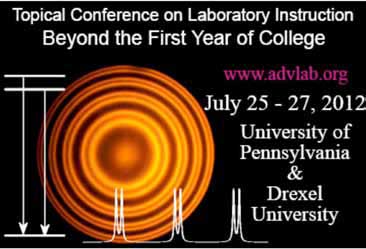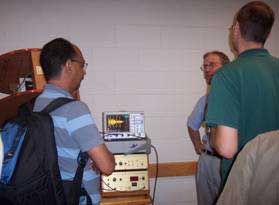2009 Topical Conference on Advanced Laboratories
Randolph Peterson and Gabe Spalding
Physics laboratory instruction after the introductory course sequence was the focus of last summer’s advanced lab topical conference, held at the University of Michigan on July 23–25, 2009. One hundred and fifty participants from one hundred universities and colleges came to explore the meaning and purpose of advanced undergraduate laboratories and research experiences in the physics curriculum. Broadly the conference goals were that attendees should have come away with:- An understanding of the wide variety of curricula used for laboratory instruction;
- Techniques for programmatic preparation for undergraduate research and for integration of undergraduate research with the instructional laboratory curriculum;
- Methods for assessing student understanding in laboratory instruction, including in particular assessment of writing;
- A broader view of teaching strategies and pedagogy for the laboratory;
- A knowledge of, and hands-on experience with, new or improved experiments and techniques; and
- Knowledge of commercially available equipment appropriate for advanced labs.
Ten invited speakers addressed these issues by reflecting on their own experiences and lab programs. There were three panel discussions to explore these issues, followed by breakout discussion sections related to more specific subfields of research or laboratory instruction, such as teaching electronics, programming and interfacing of computers with laboratory equipment, and new experiments in fields such as biophysics and condensed matter physics.

In addition to the discussion and presentations, there were 54 workshops on advanced lab experiments and interfacing languages in the afternoons, allowing everyone to "walk-the-walk" of the hands-on experiential education that advanced labs represent. Faculty from the University of Michigan presented 10 of their advanced lab experiments as part of these workshops. Participants from other universities also brought complete experiments, and 12 vendors brought commercially produced instructional experiments, greatly extending the number of available workshops. While workshops using the LabVIEW and MATLAB programming languages for interfacing experiments were held for larger groups of up to 16 people, we were able to limit enrollment for the other "hands-on" workshops to 5 people at once, by repeating those workshops multiple times.
Conferences focused on this portion of the curriculum have been rare, with the last one, LabFocus, run in 1993. Last summer’s conference was also unusual in the amount and level of equipment brought by participants and vendors for hands-on, extended demonstrations and interactions. In addition, PIRA (Physics Resource Teaching Agents) provided a wide array of lab demonstrations in an evening presentation specifically tailored for advanced physics courses.
There are many reasons to suggest that it should not be another 15 years before the next focused conference on advanced labs occurs. Interest in this conference was clearly very strong, as registration had to be capped due to space limitations at 150 participants. Moreover, preliminary results of a survey regarding the status of laboratory instruction beyond the first-year courses, conducted by ALPhA (the Advanced Laboratory Physics Association), along with the input of a number of presenters, combined to make a clear case for revisiting this portion of the curriculum. At many institutions, advanced lab instruction is often very far from being a "shared" responsibility, in many cases with only one person (even at some very large institutions) bearing the load of the traditional Junior/Senior Advanced Lab over decades, often with minimal (less than $1000 per year) financial investment. The consequences of this "ghetto-ization" of the Advanced Labs are often a stagnant curriculum, with almost no content that could not have been taught 40 years ago. At the same time, based on the conference presentations, there are a number of programs that are vibrant sources of inspiration and innovation. The situation is clearly one where shared opportunities for faculty and curricular development become especially important, particularly for those institutions where the relevant instructors lack the time and supporting cohort that might be desired.

Not your typical poster session.
Dissemination and discussion of individual experiments and larger curricular models should help participants’ programs to create a more cohesive, integrated four-year arc of laboratory instruction that builds and reinforces concepts across the undergraduate curriculum. In many cases, it may also result in a move towards "co-valuing" experiment with theory and simulation in the physics major, making more room in the curriculum for new labs. That said, assessing such long-term consequences is challenging and, at this stage, a principal outcome of the conference is a set of questions facing departments. What formats work for implementation and for assessment? What new research problems have found their way into the advanced lab, and what are the advantages of injecting such "currency" into undergraduate programs? Whether discussing individual experiments, particular laboratory courses, or broader pedagogical approaches, a great deal of interaction on these questions among the participants evolved out of the invited presentations, contributed posters, panel discussions, and the wide range of engaging examples from the workshops.
The high value placed upon capstone experiences, which in many cases is dominated by experimental undergraduate research projects, was clear from many of the participants’ programs. A thrust toward more open-ended projects (and interactions with undergraduate research) within the advanced lab curricula is also motivated by progress in work on inquiry-based labs for the introductory first-year courses.
Notably, it really was by having a large gathering focused on laboratory instruction that attention was given to large curricular questions dealing, for example, with the range of goals associated with courses like the traditional Junior/Senior Advanced Lab, and the relative merit of offering laboratory instruction in focused courses that are "attached" to courses dealing with particular topics in depth versus those factors that lead programs to offer a range of "stand alone" laboratory courses. It is clear that there is a wide variety of approaches that have been adopted for the laboratory. While the formal, non-laboratory part of the physics course sequence for majors has often been described as a "spiral curriculum," which revisits, reinforces, and refines key concepts, the cohesion of laboratory curricula over the four-year experience of a typical major requires much more intentional planning than just selecting interesting or challenging experiments, because no standard cannon currently exists.
In retrospect, from the evaluations of the conference, it was a valuable experience for those involved in advanced laboratories, and needs to occur more often than the previously established window of 10–20 years between conferences with this focus. The support of the FEd (along with ALPhA, NSF, APS, AAPT, PIRA, the Physics Department of the University of Michigan, and the participating vendors) was very important to the success of this conference.
Considerable material from the presentations and breakout sessions is available online.

Waiting for the PIRA advanced labs demo show to start on Friday evening.
Randolph Peterson at The University of the South and Gabe Spalding at Illinois Wesleyan University, among many others, helped organize the 2009 Topical Conference on Advanced Laboratories.
Disclaimer - The articles and opinion pieces found in this issue of the APS Forum on Education Newsletter are not peer refereed and represent solely the views of the authors and not necessarily the views of the APS.
